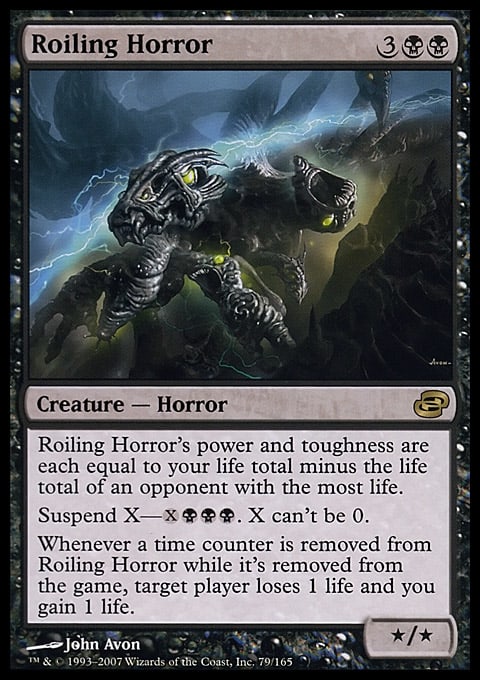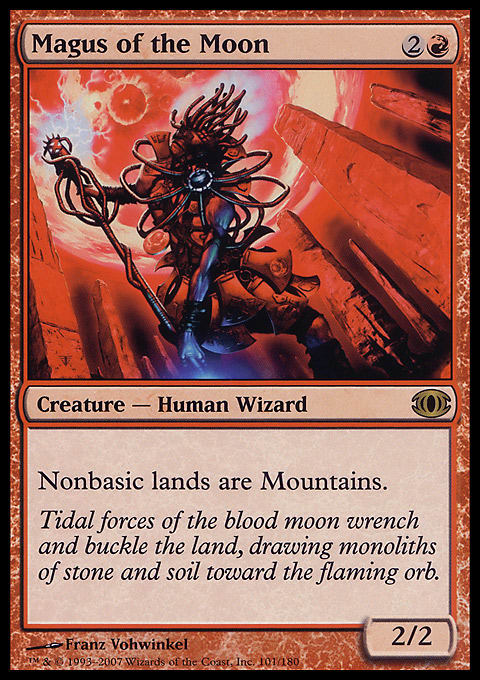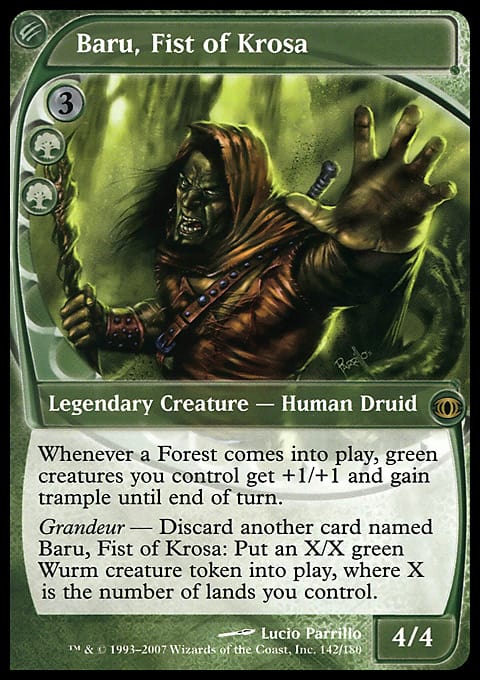Last time, we looked at Time Spiral's cycles delivering on their conceptual promise. Planar Chaos and Future Sight don't have the same highs, and maybe that's part of why those sets suffered sales-wise in their own time. These are the last expansion sets before planeswalkers, so cycles were more vital to these sets than what we're now used to. As much as I love them like they're my siblings (the way Juliana Hatfield sang about "My Sister" while not having a sister), their highest-visibility items were interesting but not scintillating.
A reminder of the Tour de Cards rules:
- I’m looking at horizontal cycles (Titans), not vertical cycles (Penumbra Bobcat/Penumbra Kavu/Penumbra Wurm). They need at least five cards, though they don’t have to be in five colors.
- No all-common cycles. They tend to be boring.
- No land/mana cycles. They tend to be too similar for my purposes. Besides, every dual land is good.
I’m grading each cycle on three categories:
- Playability – Does this cycle have any cards people want to play?
- Depth – Was it hit-and-miss or strong overall?
- Resonance – Memorable cycles should be able to pass the flavor test, although some cycles are mechanical and are not intended to have shared flavor. Still, making all the cards cost the same, have similar names, or share other characteristics can make a cycle memorable when it otherwise wouldn’t be.
Planar Chaos
The Enemy-Colored Slivers
(Necrotic Sliver, Frenetic Sliver, Darkheart Sliver, Cautery Sliver, Dormant Sliver)
Playability: B+
Depth: C
Resonance: B
Inspired by Vindicate, Frenetic Efreet, Dark Heart of the Wood, Goblin Legionnaire, and Jungle Barrier respectively, the cards' power levels are relative to their influences. Like Harmonic Sliver from Time Spiral's Sliver cycle, Necrotic Sliver is good enough to run sans buddies, as Conley Woods showed three years ago. (His sideboard has a Ghost-Lit Stalker, which makes me happy.)
Some people like Dormant Sliver to cantrip in their own Sliver decks—getting rid of it when they're ready to attack—while others like putting it in their random G/U decks to turn off somebody else's Sliver deck. Past that, if I were making two-colored Sliver decks for some reason, I doubt I'd include the others. I might include Frenetic Sliver as literally random protection against board wipe, but that's it.
The Vanishers
(Calciderm, Tidewalker, Waning Wurm, Lavacore Elemental, Deadwood Treefolk)
Playability: B+
Depth: B−
Resonance: B− (mechanical cycle with one anchor point)
And that anchor point is Calciderm explaining the difference between vanishing and the fading of uncle Blastoderm. Like Blastoderm, Calciderm is highly playable, largely because white doesn't have many 5/5s for 4. The second-place event at this old Pro Tour Qualifier saw Calciderm-based fun take second place (check out the winning R/U/G Slivers deck, too—that one's way out there). Calciderm is loved further in Frank Karsten's article here and in this Pro Tour Yokohama coverage, which features Calciderm, Fortune Thief, and a card from the next cycle.
Deadwood Treefolk is among my favorite Commander utility cards, and Tidewalker is among my favorite cards period. Blue doesn't get creatures that big for 3 mana ever. You can stick it in any mono-blue deck, as I did here and here.
The Suspenders
(Benalish Commander, Aeon Chronicler, Roiling Horror, Detritivore, Fungal Behemoth)
Playability: B+
Depth: C−
Resonance: C (mechanical cycle)
As noted above, Aeon Chronicler saw some Standard play; anything that lets you draw cards in a zone where almost nothing interacts with it will pique some blue mage's interest. The Chronicler is useful for similar reasons in multiplayer of any stripe. Benalish Commander provides a different angle for casual Soldier decks; I've seen it do great things just by being itself (which sounds like I'm an after-school special—"Learn how to be yourself, Ben, and people will want to play with you!").
Fungal Behemoth is a fun build-around, in that it looks like it plays like Benalish Commander, but it is instead sustained mainly by battlefield interactions. Putting a Soul's Might on a Behemoth when you have 5 +1/+1 counters on other creatures will make it a 15/15—it will be a base 10/10 with 5 counters on it. As much doubling as Mark Rosewater has inserted into sets, there are very few opportunities for tripling, so if that's your thing, this is your Fungus.
I didn't know until researching this cycle that detritivore is a real word, although it's about the last thing you'd associate with a red card. I've had Detritivore in my Radha deck for a while; it needs the game to have at least four players before it's a non-dead (undead?) card. And there are people who like Roiling Horror, but I do not understand them.
Magi of the Lands
(Magus of the Tabernacle, Magus of the Bazaar, Magus of the Coffers, Magus of the Arena, Magus of the Library)
Playability: B+
Depth: B
Resonance: B+
Time Spiral's Magi sprang from artifacts; Planar Chaos's sprang from lands. And as the lands inspiring these cost far more money than the artifacts behind Time Spiral's, these are the closest we'll get to running some of these abilities. Magus of the Arena is in the Marath Commander (2013 Edition) deck, so you'll see more of it soon. I had Magus of the Library in an Arboria deck the main goal of which was to cast Inner Calm, Outer Strength on a thing I was about to Phthisis off suspend for a two-card kill. That's all I've figured out to do with it; I hope there's more.
Unlike the other abilities, which are rarely played as lands in Commander, Magus of the Coffers is an obvious backup for Cabal Coffers; having both of them is better than having Bazaar of Baghdad and Magus of the Bazaar. A lot of playgroups would play differently if Magus of the Tabernacle showed up; it might work in my new Daxos of Meletis Commander deck. Who pays mana to keep the small things that could block Daxos?
Points to the Arena and Cabal Coffers artwork inspiring their Magi. I can't tell at small scale, but it looks like Magus of the Bazaar might be walking among tatters of the old Bazaar.
The Color-Shifted Legends
(Crovax, Ascendant Hero, Braids, Conjurer Adept, Mirri the Cursed, Akroma, Angel of Fury, Jedit Ojanen of Efrava)
Playability: A−
Depth: B+
Resonance: A−
Taking previous legendary creatures and giving them new stories, these are most popular outside Commander, but there are applications across the casual spectrum. I've built with Braids here, and the reports from a friend with the deck is that it can be silly. Mirri's a premium, cheap flyer, which black loves as much as it loves the relatively scarce instant removal it gets. Akroma saw some Standard play—check out Mikko Nurmi's amazing R/G ramp deck from 2007 Worlds here—and Crovax, as a proto-Elesh Norn, was an occasional Extended card, as Eric Neilson's deck shows here. And Jedit Ojanen is the largest forestwalker ever; if that's handy in your group, try him out.
The built-in callbacks were great flavor, especially retelling Crovax's and Mirri's stories, and the flavor texts explicitly discuss the alternate timeline. Akroma has morph instead of flavor text, but since the original Akroma was created by Ixidor, Reality Sculptor, the morph tells its own story. In many ways, Planar Chaos needed this cycle to succeed for the set's ambitions to cohere. I think it worked.
The Wedge Dragons
(Oros, the Avenger, Intet, the Dreamer, Teneb, the Harvester, Numot, the Devastator, Vorosh, the Hunter)
Playability: A
Depth: A
Resonance: A−
As the second-ever cycle of cards requiring wedge mana to cast (the first included Lightning Angel) and as clear callbacks to Invasion's legendary Dragons, these mixed new and old successfully. Before the 2011 Commander product gave the wedges more identity, these were the available wedge commanders (them and Doran, the Siege Tower). While it's easy to look at the 6/6 flying bodies and the weird colors and lump them together, they make different decks. Teneb has been the most vicious commander in my experience, but Numot makes the most vicious decks; play Catastrophe, float mana for Numot, and the game is yours. Vorosh loves dealing commander damage, Intet is tricksy, and Oros is hard to peg but normally provides good value.
The one trouble with this cycle is its implications for Planar Chaos as a set. This feels less like a cycle belonging the story and more like someone asked, "What if we made these Dragons? I guess they'd go here." I suppose if I'm worried about that, I might want to care about Future Sight . . .
Future Sight
The Creatureshapers
(Goldmeadow Lookout, Cloudseeder, Skirk Ridge Exhumer, Sparkspitter, Llanowar Mentor, Sliversmith)
Playability: C
Depth: C
Resonance: B
The biggest deal when this cycle came out wasn't that they made tokens of cards that already existed—Kher Keep already did that. No, the biggest deal was Goldmeadow Lookout making tokens of Goldmeadow Harrier, which didn't yet exist. That didn't make it good—in fact, none of these is great. You can make Metallic Slivers with the cleverly-named Sliversmith, but in most, decks you're discarding other, better Slivers for them. As with many Spellshapers, if you don't get value out of discarding a card, the effect should matter a lot, and making various small tokens doesn't get there. It's a cool cycle in theory, but it didn't work out.
The Recurrence of Time
(Chronomantic Escape, Reality Strobe, Festering March, Arc Blade, Cyclical Evolution)
Playability: B−
Depth: B+
Resonance: B− (Mechanical cycle, but well-named and conceived)
I am down on this cycle compared to Gatherer raters, most of whom play these as the premier Jhoira's Timebug/Rift Elemental combos. If you build that deck, you'll have fun with these, but otherwise, they're not worth much. The best ones are the ones you don't mind hard-casting, i.e. not Festering March or Cyclical Evolution. The slow, narrow nature of this cycle is hard to take years after they came out and seemed cool, but maybe I'm too harsh.
Magi of the Enchantments
(Magus of the Moat, Magus of the Future, Magus of the Abyss, Magus of the Moon, Magus of the Vineyard)
Playability: A−
Depth: B+
Resonance: A−
These enchantment-inspired Magi are the most playable of the block. Being based on enchantments meant these Magi could copy their forebears' mana costs exactly, making them literal creature versions of the enchantments. Magus of the Moon has seen play whenever Blood Moon has seen play; the creature caught up to the enchantment in price eventually. Magus of the Moat is about $197 cheaper than Moat, and being an 0/3 creature is not too different than being an enchantment in most multiplayer settings. I've known it to do great work in Vish Kal, Blood Arbiter Commander decks, and it would sit nicely with any skies-heavy deck (Gisela, Blade of Goldnight seems to be a great fit as built-in Magus protection).
Magus of the Abyss wipes itself out eventually, unlike The Abyss. It isn't too far from Anowon, the Ruin Sage in playability, so maybe you have a home for it. Magus of the Vineyard was in the original Commander product with Riku of Two Reflections; I don't know if people kept it in, but it's interesting. Magus of the Future is as good as Future Sight, but as much as I love the card, I have difficulty finding a spot for it in decks. Paying 5 mana is a lot for me to increase my options. But if that's my gripe on the cycle, it's a pretty good cycle.
The Grandest Legends
(Oriss, Samite Guardian, Linessa, Zephyr Mage, Korlash, Heir to Blackblade, Tarox Bladewing, Baru, Fist of Krosa)
Playability: B+
Depth: B+
Resonance: B+
Linked by grandeur, which only shows up on these five cards, the cycle is probably best known to casual players through Baru, who's powerful in singleton as well as when you can make instant-speed free tokens. The best known from Standard is Korlash, as Pat Chapin wrote about here. If you have a substitute for Damnation, his list would be fun to rebuild. I made a Baru/Oriss deck last year for a friend, and I would love to try it in Two-Headed Giant, where Oriss's ability is especially useful. If you can put all the Tarox Bladewings in your hand, you're threatening hasty lethal damage; that seems to be a fun combo to assemble (Pack Hunt, here is your new friend).
Oriss is based on Orim, Samite Healer; Linessa's compatriot is Alexi, Zephyr Mage; Korlash is a black-themed variant on Dakkon Blackblade; Tarox Bladewing comes from Rorix Bladewing; and Baru shares a last name with Kamahl, Fist of Krosa. It's a disjointed collection of legends to riff off, but the cycle turned out nicely for what it is.
The Pacts
(Intervention Pact, Pact of Negation, Slaughter Pact, Pact of the Titan, Summoner's Pact)
Playability: A
Depth: B−
Resonance: B− (Mechanical cycle, although with a historically unique mechanic)
You are living in Safe Prediction Land when you predict that a cycle of free spells will be played. It's obvious from reading them or noticing which ones are in Modern Masters which ones are the best. Countering a spell and destroying a creature (Pact of Negation and Slaughter Pact) are exactly what you want to pretend you can't do when tapped out, and even if you have to pay for it next turn, you dealt with the problem when it mattered. Tutoring for a green creature when you're tapped out isn't in the same category, but it's worth doing regardless, so Summoner's Pact is worth its reprint. Intervention Pact and Pact of the Titan don't promise nearly enough to be worth as much in the average game.
But not every game is average, and Hive Mind—which combines with a Pact to give your opponent a lose condition—does not create an average board state. And it is in Hive Mind decks that Pact of the Titan made its mark along with Pact of Negation. Jacob Van Lunen wrote an early article on it that describes all you need to know. Given that Hive Mind was intended as a multiplayer card, its combo with Pacts is viable in multiplayer should you wish to try the combo out.
And maybe it's odd to say that the Pacts' fame is from a two-card, instant-win combo. But again, when you make free spells, don't be surprised if they go in weird places.
By the way, pacts require two parties to make them. Who's making these pacts? A Titan with itself? A Summoner and the tutored-for creature? Nothing on the card gives a clue. It's like talking about a single-country treaty, great control decks in Zendikar Draft, that meaningful Justin Bieber track, or tasty pecans—the contradiction in terms is too high to think about it for long.
Conclusion
The cycles of Planar Chaos and Future Sight brought some focused nostalgia, some unfocused nostalgia, and some ideas whose reach exceeded their grasp. Future Sight's dip in cycle quality, especially in the uncommons, might have been a large part of its undoing. Cycles have been anchor points in set understanding for years, and Future Sight needed its anchor points to be perfect for the rest of the set to gel around them. Llanowar Mentor and Festering March couldn't be that gel, and the set’s reputation might be linked in part to that noncohesiveness.
In the next Tour de Cards entry, we'll see that WotC took the branding power of cycles to a new level. But until then . . .




































